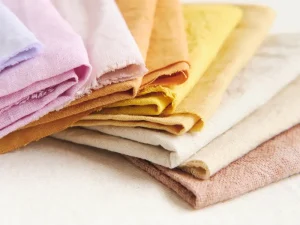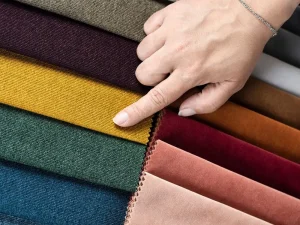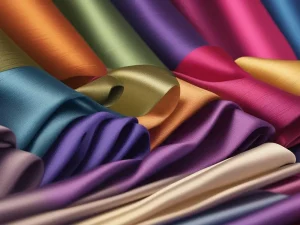'직물'이라는 용어는 우리의 일상과 닮아 있습니다. 우리는 즐겨 입는 스웨트셔츠부터 현관 매트까지 모든 것에 패브릭을 사용합니다. 시장에는 말 그대로 수많은 종류의 패브릭 소재가 있습니다. 사업체, 봉제업체, 일반 소비자 모두 이러한 원단 유형을 알아야 합니다. 일상 생활에 대한 정보에 입각 한 결정을 내리는 데 도움이 될 것입니다. 다양한 원단을 알면 상황에 맞는 가장 적합한 원단을 쉽게 선택할 수 있습니다. 더 이상 시간을 낭비하지 말고 지금 바로 배워보세요. 여기 모든 종류의 옷과 소재를 다루는 전문가가 작성한 블로그가 있습니다. 또한 모든 유형의 장점과 한계에 대해 설명하여 정보에 입각한 결정을 내리는 데 도움을 줍니다.
첫째, 패브릭이란?

간단한 질문부터 시작하겠습니다: 원단이란 무엇인가요? 간단히 말해서 원단은 의류에 필수적인 요소입니다. 섬유는 의류의 기본 소재를 구성하며, 제조업체는 이를 바탕으로 추가 가공을 합니다. 제조업체는 원사를 편직하고 직조하여 의류를 생산합니다. 일반적으로 사람들은 GSM 또는 평방미터당 그램을 사용하여 원단을 측정합니다. 원단의 무게와 두께를 고려하여 실제 비용을 결정합니다.
다양한 종류의 원단
크게 보면 다양한 원단은 크게 두 가지 카테고리로 분류됩니다:
- 내추럴 패브릭
이름에서 알 수 있듯이 면, 실크, 양모 등 곤충, 식물, 동물 등 천연 소재에서 천연 원단을 얻습니다.
- 합성 직물
반면 제조업체는 실험실과 산업 현장에서 나일론과 폴리에스테르와 같은 합성 섬유를 인위적으로 제조합니다.
솔직히 말해서 의류 소재의 종류는 무수히 많기 때문에 한 블로그에 요약하는 것은 불가능합니다. 하지만 저희 전문가들이 목록에서 눈에 띄는 것들을 정리해 보았습니다.
면

면은 가장 보편적이고 다재다능한 원단입니다. 부드럽고 지속 가능하기 때문에 다양한 용도에 이상적입니다. 코튼은 전 세계의 검은 토양에서 자란 목화 식물로 만들어집니다. 통기성이 뛰어나고 땀을 흡수하기 때문에 무더운 여름에 가장 적합한 원단입니다. 관리도 쉬워 중성 세제로만 세탁하면 됩니다. 유일한 한계는 면이 다른 합성 소재만큼 늘어나지 않는다는 점입니다. 제조업체에서는 티셔츠, 드레스, 셔츠, 가정복, 정장 등을 만드는 데 이 다용도 원단을 사용합니다.
Wool
양모는 가장 오래된 직물 중 하나입니다. 원시 시대부터 사람들은 양이나 산양과 같은 양털 동물에서 양모를 얻었습니다. 추운 날씨에 가장 적합한 천연 섬유입니다. 이 원단은 체온을 조절하여 외부 온도로부터 피부를 단열합니다. 코트, 모자, 가디건 등과 같은 겨울 의류에 적합하고 선호되는 원단입니다.
실크

가장 비싸고 고급스러운 직물 중 하나는 실크입니다. 기원전 6000년, 중국 황제의 부인이 처음으로 실크를 발견했습니다. 그 이후로 중국 실크는 세계 시장에서 입지를 유지하며 역사적인 실크 루트의 기원이 되었습니다. 사람들은 뽕잎을 먹는 누에에서 실크를 얻습니다. 디자이너들은 이 직물을 사용하여 문화 및 민족 의상과 현대 패션을 만듭니다. 하지만 비용이 비싸서 쉽게 감당할 수 없습니다. 그래서 직물 소유자와 디자이너들은 새틴과 같은 다른 옵션으로 전환했습니다.
시폰
쉬폰은 1700년대에 유럽에서 발명되었으며 가볍고 순수한 매력으로 인기가 높습니다. 일반적으로 원단 공급업체 및 제조업체 폴리에스테르, 나일론 또는 실크를 혼합하여 만들 수 있습니다. 하늘하늘하고 반짝이는 여름 드레스를 만드는 데 적합합니다. 남아시아에서 쉬폰은 여성용 에스닉 사리를 바느질하는 데 널리 사용됩니다.
데님
현대 세계에서 가장 인기 있는 원단 중 하나는 데님입니다. 스타일리시하고 내구성이 뛰어나며 신축성이 뛰어나고 몸을 감싸줍니다. 데님은 일반적으로 파란색이지만 다양한 염료 옵션도 있습니다. 사람들은 데님을 원단 그 자체라기보다는 원단으로 만든 예술품이라고 생각합니다. 제조업체는 천연 천과 인조 천을 혼합하여 데님을 만듭니다. 가장 일반적인 버전은 100% 면으로 만들어지며, 라이크라 또는 스판덱스와 결합하는 경우도 있습니다. 현재 시중에는 데님 원단과 유사한 천 소재가 시판되고 있습니다.
벨벳
고대부터 인기를 끌었던 벨벳이 다시 한 번 시장에 등장했습니다. 내구성이 뛰어나고 광택이 나는 소재로 원단에 원하는 느낌을 줍니다. 부드럽고 플러시한 느낌의 합성 소재입니다. 미지근한 물에 중성 세제를 부어 직물을 쉽게 청소할 수 있습니다. 하지만 벨벳을 오래 유지하려면 문지르지 마세요.
Organza
오간자는 실크에서 유래한 또 다른 얇은 원단입니다. 가볍고 도톰하며 다양한 스타일과 의상으로 스타일링할 수 있습니다. 가볍고 부드러운 질감으로 원하는 모양을 만들 수 있습니다. 현대에 오간자는 에스닉 웨딩드레스, 사리, 블라우스 등에 많이 사용됩니다.
리넨
많은 사람들이 린넨을 합성 섬유라고 생각하지만, 린넨은 천연 섬유입니다. 리넨은 벨기에에서 자생하는 아마 식물의 줄기에서 유래했습니다. 면과 매우 유사한 린넨은 훨씬 더 무겁고 강합니다. 통기성이 뛰어나며 다양한 스타일링이 가능합니다.
레이온
인조 실크라고도 알려진 레이온은 셀룰로오스로 만든 인공 섬유입니다. 피부에 닿는 촉감이 섬세하고 부드럽습니다. 가장 좋은 점은 통기성과 흡수성이 뛰어나며 실크의 느낌을 그대로 재현한다는 점입니다. 블라우스, 상의, 에스닉 드레스 등 다양한 의상을 스타일링하는 데 사용할 수 있습니다.
가죽
가죽의 우아함에 대해 모르는 사람이 세상에 또 있을까요? 사람들은 염소, 버팔로, 뱀, 코뿔소 등 무두질한 동물 가죽에서 가죽을 얻습니다. 제조업체는 다양한 스타일과 색상으로 맞춤 제작할 수 있습니다. 일반적으로 지갑, 벨트, 지갑, 핸드백, 신발 등에 사용됩니다.
Georgette
몸에 완벽하게 밀착되는 얇은 소재를 찾고 있다면 조젯을 선택하세요. 오가닉과 인조 두 가지 유형이 있습니다. 오가닉은 편안함을 제공하는 반면, 인조는 적응성을 제공합니다. 이 원단은 전 세계 발리우드 스타일의 사리에 널리 사용됩니다. 직물이 쉽게 변색되고 찢어질 수 있기 때문에 내구성이 우려됩니다.
비닐 패브릭
사람들은 비닐 원단을 PVC, 인조 가죽 등 다양한 이름으로 알고 있으며, 종종 진짜 가죽의 훌륭한 대안으로 간주합니다. 이름에서 알 수 있듯이 제조업체에서는 바이커 의류와 겨울 의류를 만드는 데 사용합니다. 가장 좋은 점은 동물 학대 없이 가죽의 장점을 누릴 수 있다는 점입니다. 하지만 극한의 기상 조건에서 원단의 수명에 대한 불확실성이 여전히 존재합니다. 한 가지 조언을 드리자면 원단을 반복해서 세탁하지 마세요. 그 대신 젖은 천으로 얼룩을 닦아내는 것이 좋습니다.
폴리에스테르
폴리에스테르의 일관성에 대해 생각하면 틀릴 수 있습니다. '폴리에스터'는 직물 그 이상의 합성 섬유를 의미합니다. 1970년대에 발명된 폴리에스터는 흔히 '기적의 원단'으로 여겨집니다. 폴리에스터의 가장 큰 장점은 제조업체가 폴리에스터를 저렴하게 생산하면서도 내구성을 유지할 수 있다는 것입니다. 하지만 폴리에스터는 지속 가능하지 않고 장기적으로 생분해되지 않는 폐기물을 유발할 수 있다는 단점도 있습니다.
스판덱스
신축성이 뛰어난 스판덱스는 라이크라, 엘라스테인이라고도 불립니다. 스판덱스는 신축성이 뛰어나 활동복과 피트니스 웨어에 적합합니다. 가장 좋은 점은 다른 소재와 함께 사용하여 옷의 질감을 더할 수 있다는 것입니다.
새틴
실크의 대체재로 자주 사용되는 새틴은 광택이 있고 광택이 나는 원단입니다. 전통적으로 실크가 새틴 제조의 주요 원료였다는 사실에 놀랄 수도 있습니다. 하지만 현재 제조업체와 과학자들은 실험실과 산업 현장에서 새틴을 가공하여 비용을 절감할 수 있습니다.
나일론
나일론은 합성 천의 주원료입니다. 초기에는 제조업체들이 나일론으로 텐트와 낙하산을 만들었습니다. 하지만 최근에는 바이커 재킷, 윈드치터 등으로 나일론의 사용이 확대되고 있습니다.
코튼 플리스
코튼 플리스는 면과 플리스의 합성어입니다. 간단히 말해서 원단의 한쪽 끝은 매끄럽고 다른 쪽 끝은 따뜻합니다. 가장 좋은 점은 단열성이 뛰어나 운동복에 안성맞춤이라는 점입니다.
레이스
우아함을 반영하는 가장 디자이너적인 천의 종류 중 하나는 레이스입니다. 이 소재는 섬세하기 때문에 조심스럽게 다뤄야 합니다. 예를 들어 세탁과 다림질에 주의하세요. 하지만 우아하고 드레스, 상의 등 다용도로 사용할 수 있습니다.
혼합 패브릭
위의 유형 외에도 제조업체는 시중에서 다른 혼합 원단을 제공합니다. 혼합 원단은 폴리 쉬폰 또는 폴리 조젯과 같이 내구성과 우아함을 제공하는 두 가지 이상의 원단을 혼합한 것입니다. 혼합 직물의 주요 목적은 비용을 절감하고 제품의 가치를 높이는 것입니다.
의류는 어디에서 구입할 수 있나요?
이제 주요 질문이 생깁니다: 어디서 양질의 천 소재를 구입할 수 있을까요? 당연히 최고의 의류 공급업체 를 찾아보세요. 신뢰할 수 있는 원단 제조업체를 신뢰하면 목적에 맞는 다양한 옷을 제공할 수 있습니다. 도매업체와 공급업체의 리뷰를 추가로 확인하여 정보에 입각한 결정을 내릴 수 있습니다.
앞으로의 방향
위에 언급된 옷들은 눈에 띄는 옷의 종류일 뿐, 선택의 폭은 무궁무진합니다. 신뢰할 수 있는 섬유 브랜드나 현지 마켓에서 더 다양한 제품을 찾아볼 수 있습니다. 각 원단 종류에 대해 자세히 알아보고 필요에 가장 적합한 것을 선택하세요.
